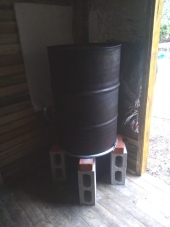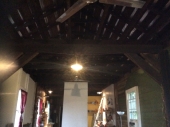(Hey Bill don't hate me too much for a bit of a critiquing-editing of you response to Cesca...

...apologies if I crossed a line...)
Quarter sawn wood, is "sometimes" milled the way Bill has suggested. Though we often render cants (i.e. tree - log - bolt - cant) into quarter sawn stock without using the "quartering modality" of milling. Instead we rely on a swing blade saw and/or selective band milling, with very careful turning of stock, which yields more board footage and better grade "quarter sawn" stock. As Bill did suggest, there are milling methods referred to as "quartering" and this does yield "quarter grain timber and boards," (as well as wasting a lot of wood.) However, quarter sawn means (Bill's description was...good...but perhaps not complete) that the annular rings of the tree run at 60° to 90° to the face of the stock as viewed from the end of the material. This wood distorts much less, is very dimensionally stable, and shrinks more in thickness than in width compared to "plain" or "rift" sawn. High end furniture, flooring and general woodworking is always made of "quarter grain" stock. Rift sawn stock has the annular rings forming a "smile" shape on the end of the stock, and are always less than 60° to the face.
The dominate board shown in you photo does appear to be a type of Conifer species, as Bill suggested, with the "pith" (inside of the tree) facing up and the top end (crown or leafing portion) of the tree facing the photographer. Reading grain is a must for good woodworking and especially advance systems like "green woodworking" and timber framing modalities.
Now what I am about to write is partly subjective and partly methodolgy of a give style...
In order to achieve vertically use of the board stock, you will indeed have to have nailers...These do not have to be 2"x2" (50mm x 50mm) stock. They can be, but the minimum thickness is 20 mm (~3/4") and can go up from there depending on the "rainscreen" system to be used. I do not condone any wall diaphragm design that does not have and engage an "active"
"rainscreen wall system."
What Bill describe is considered a "passive" rainscreen as the nailers are running only horizontally and the is not positive drafting effect within the cladding system. So to achieve an "active system" you must, as Bill suggested, wrap the structure in something like rockwool board, filter cloth, or building paper if using just loose fill insulation. We do not condone or use any types of "plastic warps" in any of our wall systems AT ALL. Most...if not all...actually fail in real world application of achieving good permeability for moisture migration/mitigation. Once the framework of the structure is clad in you chosen method, "vertical" nailers in line with key structural features are put on, the horizontal, thus forming an air space for a proper "active" drafting effect to take place behind the siding.
We have seen modern copies of "Shingled Capes" in Maine's maritime region built and needing residing in a few years with pealing paint and other issues while their neighbors home has pine shingles over 100 years old that are still in excellent condition...The difference? Active rainscreen and not shingles nailed up against plastic or tyvek house wrap...
We side with almost always vertical siding (like board and batten) as this is the most traditional in many places we work and the types of siding we find on vintage architecture we restore (not always though.) Vertical boards also last much longer, as I have said before, than boards that are laid horizontally. I would further suggest that with the proper "rainscreen system" the battens can actually be omitted if not engaged as part of the attachment method. What I mean by that is, when installed "traditional board and batten" or "little board-big board" it is the "batten or little board" that receives the fastener, thereby "cleating" the wider board to the wall assembly without any nails in it, thereby letting the larger board expand and contract with the seasons. It could also be possible to take your pallet boards which are not very long and recut them into 500 mm (~16" or more) lengths and laying them like "shakes." (Shakes are heavy and think shingles) We have done this many time over the years.
Good luck, and let us know how thing progress...
j

 1
1








 1
1
























 ...apologies if I crossed a line...)
...apologies if I crossed a line...)













